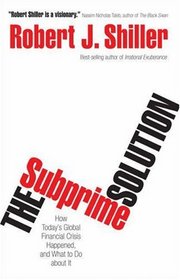Rhiannon reviewed The Subprime Solution: How Today's Global Financial Crisis Happened, and What to Do about It on + 6 more book reviews
The official "book flap" review does a good job of outlining the plot of this economics book. As an undergrad econ major, I found the book was not too hard to read. I think the primary audience is everyone from politicians to teachers. Shiller is a star in the economics world for his support of social and psy-economics. For instance, on page 44 he discussed the way the housing boom was like a disease epidemic, in the way that an optimistic view of the market spread from person to person. I will say, I think the name of the book "The Subprime Solution" is not the most appropriate name for the book. That's because the entire financial crisis that is described in the book was not caused by subprime lending and the funny thing is that Shiller doesn't think so either, because he encourages Subprime Lending if done the right way - with insurance called "Continuous Workout Mortgages". In 2005, (during the market boom) the author was involved in a survey of SanFran home buyers that found that even though the usual expected price improvement over the next ten years was around 10% some people had expectations of their home price appreciating 50% in ten years. Shiller says the problem is something called "information cascades" which is when people ignore their own experiences because they feel that everyone else just can't be wrong. When they ignore their own data, the quality of the information available to everyone declines. So Shiller is a fan of more data sharing and more markets for housing derivatives and more lending, not less.
The second chapter, "Housing in History", takes a little focus with all the graphs of housing price trends. Luckily, the pace improves on the third chapter, "Bubble Trouble". Following all the data showing that housing prices were so much higher than could be rationally explained, he then notes that "President Bush virtually never mentioned the housing boom in his public pronouncements while it was happening". Meanwhile, leading economists were wrestling with "irrational exuberance" and the definition of "bubble". If only they could have read this book back then! Then again, Shiller was talking to them and they didn't seem to listen.
The second chapter, "Housing in History", takes a little focus with all the graphs of housing price trends. Luckily, the pace improves on the third chapter, "Bubble Trouble". Following all the data showing that housing prices were so much higher than could be rationally explained, he then notes that "President Bush virtually never mentioned the housing boom in his public pronouncements while it was happening". Meanwhile, leading economists were wrestling with "irrational exuberance" and the definition of "bubble". If only they could have read this book back then! Then again, Shiller was talking to them and they didn't seem to listen.




